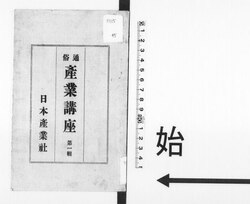File:NDL921220 通俗産業講座 第1輯.pdf

Original file (5,212 × 4,254 pixels, file size: 25.3 MB, MIME type: application/pdf, 56 pages)
Captions
Captions
Summary
[edit]| 通俗産業講座
( |
|||||||||||||||||||||||||||
|---|---|---|---|---|---|---|---|---|---|---|---|---|---|---|---|---|---|---|---|---|---|---|---|---|---|---|---|
| Author |
日本産業社 |
||||||||||||||||||||||||||
| Title |
通俗産業講座 |
||||||||||||||||||||||||||
| Volume | 第1輯 | ||||||||||||||||||||||||||
| Publisher |
日本産業社 |
||||||||||||||||||||||||||
| Language | jpn | ||||||||||||||||||||||||||
| Publication date |
1926 大正15 |
||||||||||||||||||||||||||
| Place of publication | JP | ||||||||||||||||||||||||||
| Source |
institution QS:P195,Q477675 |
||||||||||||||||||||||||||
| Creator InfoField | 日本産業社 [著] | ||||||||||||||||||||||||||
| Publication Place InfoField | 鶴見町 (神奈川県) | ||||||||||||||||||||||||||
| Subject: NDC InfoField | 604 | ||||||||||||||||||||||||||
| Extent InfoField | 114p ; 19cm | ||||||||||||||||||||||||||
| Material Type InfoField | Book | ||||||||||||||||||||||||||
| Source Identifier: JPNO InfoField | 42015101 | ||||||||||||||||||||||||||
| Date Digitized: W3CDTF InfoField | 2009-03-31 | ||||||||||||||||||||||||||
| Audience InfoField | 一般 | ||||||||||||||||||||||||||
| Title Transcription InfoField | ツウゾク サンギョウ コウザ | ||||||||||||||||||||||||||
| Volume Transcription InfoField | 1 | ||||||||||||||||||||||||||
| Publisher Transcription InfoField | ニホン サンギョウシャ | ||||||||||||||||||||||||||
| Source Identifier: NDLBibID InfoField | 000000542639 | ||||||||||||||||||||||||||
| Call Number InfoField | 特115-45 | ||||||||||||||||||||||||||
| Creator: NDLNAId InfoField | 00411365 | ||||||||||||||||||||||||||
| Contents InfoField | 標題
四 飼養法と其餌 五 蕃殖上注意すべき習性 六 産卵と孵化育雛 七 脊黄青インコの利益 第七章 藥草ヒドラスチス / 111 一 ヒドラスチスとは何か、其栽培法 二 ヒドラスチスの利益と普及 |
||||||||||||||||||||||||||
Licensing
[edit]This image is in the public domain because it is a mere mechanical scan or photocopy of a public domain original, or – from the available evidence – is so similar to such a scan or photocopy that no copyright protection can be expected to arise. The original itself is in the public domain for the following reason:
This tag is designed for use where there may be a need to assert that any enhancements (eg brightness, contrast, colour-matching, sharpening) are in themselves insufficiently creative to generate a new copyright. It can be used where it is unknown whether any enhancements have been made, as well as when the enhancements are clear but insufficient. For known raw unenhanced scans you can use an appropriate {{PD-old}} tag instead. For usage, see Commons:When to use the PD-scan tag. |
File history
Click on a date/time to view the file as it appeared at that time.
| Date/Time | Thumbnail | Dimensions | User | Comment | |
|---|---|---|---|---|---|
| current | 18:22, 24 November 2023 |  | 5,212 × 4,254, 56 pages (25.3 MB) | Wmr-bot (talk | contribs) | 上載《921220.pdf》 |
You cannot overwrite this file.
File usage on Commons
The following page uses this file:
Metadata
This file contains additional information such as Exif metadata which may have been added by the digital camera, scanner, or software program used to create or digitize it. If the file has been modified from its original state, some details such as the timestamp may not fully reflect those of the original file. The timestamp is only as accurate as the clock in the camera, and it may be completely wrong.
| Short title | |
|---|---|
| Author | |
| Keywords | https://commons.wikimedia.org/wiki/Commons:Library_back_up_project |
| Conversion program | PyPDF2 |
| Encrypted | yes (print:yes copy:no change:no addNotes:no algorithm:AES-256) |
| Page size | 2502.75 x 2042.25 pts |
| Version of PDF format | 1.7 |




